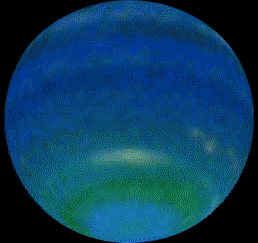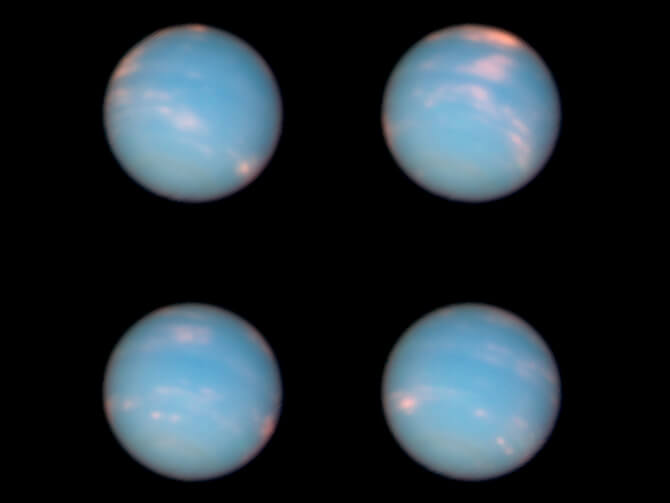The German astronomer Johann Galle discovered Neptune on September 23, 1846 after astronomers from France and England predicted the expected position thanks to disturbances in the orbit of Uranus

The eighth planet from the sun, Neptune or by its relatively new Hebrew name Rahab marks the end of the first revolution of the sun since it was discovered 165 years ago. To mark the occasion, the Hubble Space Telescope took festive pictures of the blue-green giant planet.
Radiant Neptune is the most distant planet in the Solar System since Pluto was downgraded from a planet to a dwarf planet in 2006. This unique planet study can help astrobiologists understand the variety of planetary bodies that can exist in space. Understanding Neptune's role in the formation and evolution of the solar system can provide clues to the question of how Earth itself became host to life as we know it.
German astronomer Johann Galle discovered Neptune on September 23, 1846. At the time, the discovery doubled the known size of the solar system. The planet is about 4.5 billion kilometers from the Sun, 30 times farther than Earth. Under the Sun's weak gravity from this distance, Neptune/Rahab makes a long cycle that lasts about 165 years.
The eighth planet experiences seasons similar to those of the Earth because it is tilted 29 degrees, similar to the 23 degree inclination of the Earth relative to the plane of its orbit around the Sun. Of course, in Nepon each season lasts about 40 years.
The images show that Neptune is much cloudier today than it was a few years ago, when most of the clouds were then in the southern hemisphere. Hubble's picture shows that cloud activity is moving to the Northern Hemisphere. It is now the beginning of summer in the southern hemisphere and the beginning of winter in the northern hemisphere.

In the Hubble images, the absorption of red light by the methane gas in Neptune's atmosphere gives the planet a unique watery color. The clouds are pink in color because they reflect light in the near infrared range.
A dark band near the bottom of the southern hemisphere is almost certainly caused by a decrease in fog in the atmosphere that absorbs the blue light. The strip was first photographed by the Voyager 2 spacecraft in 1989 and may be related to the polar current that creates high winds in this area. The temperature differences between Neptune's internal heat source and the icy cloud tops, more than 100 degrees Celsius, may cause instability in the atmosphere that drives large-scale weather changes.
Neptune/Rahab has an interesting history. It was Uranus that led the astronomers to Neptune. Oron, the seventh planet from the Sun is Rahab's inner neighbor. British astronomer Sir William Herschel and his sister Caroline discovered Oron in 1781. 55 put before Neptune was observed. Immediately after the discovery, Herschel commented that the orbit of Uranus does not fit the predictions according to Newton's theory of gravity. When studying Uronus in 1821, the French astronomer Alexis Beaubard estimated that another planet was pulling the giant planet out of its orbit.
Twenty years later, Urban Le Verrier of France and John Couch Adams of England, both mathematicians and astronomers, independently predicted the position of the mysterious planet by measuring the unseen effects on the orbit of Uranus. La Varia sent a letter describing the predicted position of the planet to the German astronomer Johann Gottfried Galle of the Berlin Observatory. Over the course of two nights in 1846, Galle discovered and identified Neptune as a planet, less than a degree above the position where Le Verrey had seen it. The discovery is considered a success of Newton's theory of gravity in understanding the universe.
Galle was not the first to observe Neptune. In December 1612, while observing Jupiter and its moons with his self-made telescope, the astronomer Galileo Galilei recorded Neptune in his observation notebook, but he mistook it for a star. A month later, in January 1613, he wrote that the star appeared to be moving relative to the other stars, but despite this he did not recognize Neptune as a planet because he did not make follow-up observations, so he missed the credit for the discovery.
Neptune/Rahab is not visible to the naked eye, but only in binoculars or small telescopes at the very least. It can be found in the Aquarius group, close to the border with the Capricorn group.
Neptune-sized planets are very common around other stars. NASA's Kepler space telescope launched in 2009 to hunt for Earth-like planets has found quite a few small planets, including many the size of Neptune.

4 תגובות
https://www.hayadan.org.il/why-astrology-is-not-a-sciene-0202001/
Dan and Miriam:
Do you really believe the nonsense you wrote?
Astrology is an older science than astronomy and already the Babylonians and the Chinese treated it with reverence!!!!!
Shame on you - in the name of science, you are rejecting real, established and correct science to no end!
Who dares to state that astrology is not a science? Is the study of protons, lizards, germs and black holes a science at all?
Did you know that, contrary to science, about 80% of astrologers' observations come true and this is beyond statistical calculations?